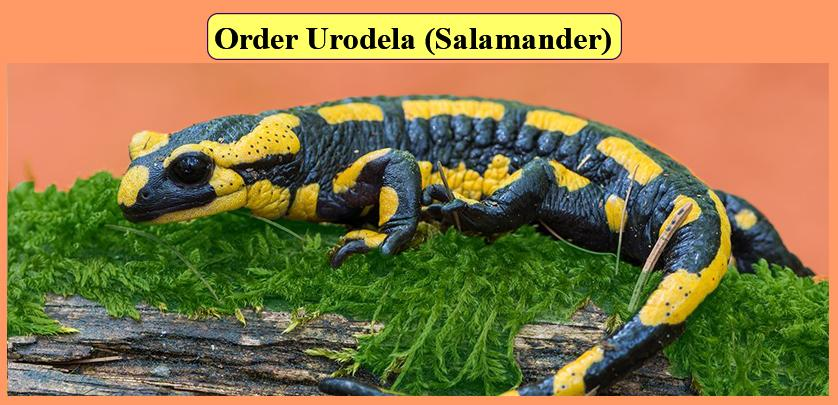
Salamandra is from the order:
(a) Apoda
(b) Urodela
(c) Anura
(d) Both (a) and (c).
Answer
507k+ views
1 likes
Hint: Salamandra is a genus of salamanders that are distinguished by their lizard-like appearance, with slender bodies, blunt snouts, short limbs, and a tail. All salamanders belong to a particular order, as a significant amount of amphibians do.
Complete step by step answer:
- Salamandra is the genus of salamanders, the amphibians. They belong to the order Urodela.
- They are known because of their lizard-like appearance, having a slender body with short limbs, blunt snouts, and a tail in both larvae and adult stages. They have moist skin (except newts) and many of them have bright colors to ward off predators.
- Salamandra specifically refers to the genus of six species of salamanders present in central and southern Europe, Northern Africa, and western Asia.
- They are mostly found to be mostly terrestrial or semi terrestrial in the case of adults, but during breeding may come to aquatic habitats.
- Different species of salamanders have different methods of respiration. The systems can involve gills, lungs, skin, and the membranes of mouth and throat. Larval salamanders breathe mainly from gills.

So, the correct answer is ‘Urodela’.
Additional information:
- The clade Apoda forms a major part of the order Gymnophiona which consists of all modern caecilians and their ancient relatives.
- The order Anura is composed of all frogs and toads.
- All the mentioned three orders belong to the class Amphibia, animals in this class are all amphibians.
Note:
- All modern salamanders belong to the clade Caudata. However, in some cases, the term is used instead of Urodela. Caudata consists of salamanders and newts.
- The skin of some species of salamanders contains the powerful poison tetrodotoxin.
- They are capable of regenerating limbs and other body parts.
Complete step by step answer:
- Salamandra is the genus of salamanders, the amphibians. They belong to the order Urodela.
- They are known because of their lizard-like appearance, having a slender body with short limbs, blunt snouts, and a tail in both larvae and adult stages. They have moist skin (except newts) and many of them have bright colors to ward off predators.
- Salamandra specifically refers to the genus of six species of salamanders present in central and southern Europe, Northern Africa, and western Asia.
- They are mostly found to be mostly terrestrial or semi terrestrial in the case of adults, but during breeding may come to aquatic habitats.
- Different species of salamanders have different methods of respiration. The systems can involve gills, lungs, skin, and the membranes of mouth and throat. Larval salamanders breathe mainly from gills.

So, the correct answer is ‘Urodela’.
Additional information:
- The clade Apoda forms a major part of the order Gymnophiona which consists of all modern caecilians and their ancient relatives.
- The order Anura is composed of all frogs and toads.
- All the mentioned three orders belong to the class Amphibia, animals in this class are all amphibians.
Note:
- All modern salamanders belong to the clade Caudata. However, in some cases, the term is used instead of Urodela. Caudata consists of salamanders and newts.
- The skin of some species of salamanders contains the powerful poison tetrodotoxin.
- They are capable of regenerating limbs and other body parts.
Latest Vedantu courses for you
Grade 11 Science PCM | CBSE | SCHOOL | English
CBSE (2025-26)
School Full course for CBSE students
₹41,848 per year
Recently Updated Pages
Master Class 11 Business Studies: Engaging Questions & Answers for Success

Master Class 11 Economics: Engaging Questions & Answers for Success

Master Class 11 Accountancy: Engaging Questions & Answers for Success

Master Class 11 Computer Science: Engaging Questions & Answers for Success

Master Class 11 English: Engaging Questions & Answers for Success

Master Class 11 Maths: Engaging Questions & Answers for Success

Trending doubts
The flightless birds Rhea Kiwi and Emu respectively class 11 biology CBSE

1 litre is equivalent to A 1000mL B 100cm3 C 10mL D class 11 physics CBSE

A car travels 100 km at a speed of 60 kmh and returns class 11 physics CBSE

Name the Largest and the Smallest Cell in the Human Body ?

Explain zero factorial class 11 maths CBSE

In tea plantations and hedge making gardeners trim class 11 biology CBSE




